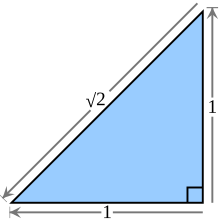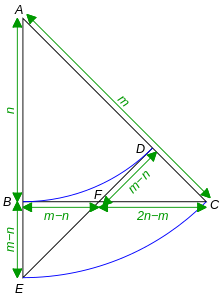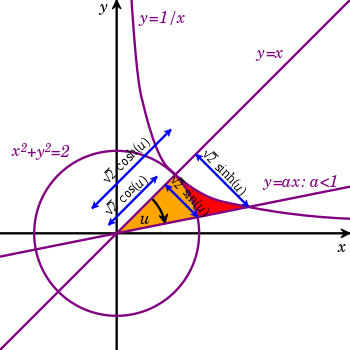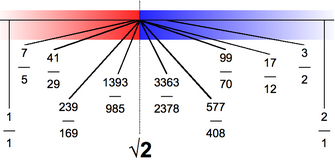Square root of 2
 The square root of 2 is equal to the length of thehypotenuseof anisoscelesright trianglewith legs of length 1. | |
| Representations | |
|---|---|
| Decimal | 1.4142135623730950488... |
| Continued fraction | |
Thesquare root of 2(approximately 1.4142) is a positivereal numberthat, when multiplied by itself or squared, equals thenumber 2.It may be written in mathematics asor.It is analgebraic number,and therefore not atranscendental number.Technically, it should be called theprincipalsquare rootof 2, to distinguish it from the negative number with the same property.
Geometrically, the square root of 2 is the length of a diagonal across asquare with sides of one unit of length;this follows from thePythagorean theorem.It was probably the first number known to beirrational.[1]The fraction99/70(≈1.4142857) is sometimes used as a goodrational approximationwith a reasonably smalldenominator.
SequenceA002193in theOn-Line Encyclopedia of Integer Sequencesconsists of the digits in thedecimal expansionof the square root of 2, here truncated to 65 decimal places:[2]
- 1.41421356237309504880168872420969807856967187537694807317667973799
History[edit]

TheBabylonianclay tabletYBC 7289(c. 1800–1600 BC) gives an approximation ofin foursexagesimalfigures,1 24 51 10,which is accurate to about sixdecimaldigits,[3]and is the closest possible three-place sexagesimal representation of,representing a margin of error of only –0.000042%:
Another early approximation is given inancient Indianmathematical texts, theSulbasutras(c. 800–200 BC), as follows:Increase the length [of the side] by its third and this third by its own fourth less the thirty-fourth part of that fourth.[4]That is,
This approximation, diverging from the actual value ofby approximately +0.07%, is the seventh in a sequence of increasingly accurate approximations based on the sequence ofPell numbers,which can be derived from thecontinued fractionexpansion of.Despite having a smaller denominator, it is only slightly less accurate than the Babylonian approximation.
Pythagoreansdiscovered that the diagonal of asquareis incommensurable with its side, or in modern language, that the square root of two isirrational.Little is known with certainty about the time or circumstances of this discovery, but the name ofHippasusof Metapontum is often mentioned. For a while, the Pythagoreans treated as an official secret the discovery that the square root of two is irrational, and, according to legend, Hippasus was murdered for divulging it, though this has little to any substantial evidence in traditional historian practice.[5][6]The square root of two is occasionally calledPythagoras's numberorPythagoras's constant.[7]
Ancient Roman architecture[edit]
Inancient Roman architecture,Vitruviusdescribes the use of the square root of 2 progression orad quadratumtechnique. It consists basically in a geometric, rather than arithmetic, method to double a square, in which the diagonal of the original square is equal to the side of the resulting square. Vitruvius attributes the idea toPlato.The system was employed to build pavements by creating a squaretangentto the corners of the original square at 45 degrees of it. The proportion was also used to designatriaby giving them a length equal to a diagonal taken from a square, whose sides are equivalent to the intended atrium's width.[8]
Decimal value[edit]
Computation algorithms[edit]
There are manyalgorithmsfor approximatingas a ratio ofintegersor as a decimal. The most common algorithm for this, which is used as a basis in many computers and calculators, is theBabylonian method[9]for computing square roots, an example ofNewton's methodfor computing roots of arbitrary functions. It goes as follows:
First, pick a guess,;the value of the guess affects only how many iterations are required to reach an approximation of a certain accuracy. Then, using that guess, iterate through the followingrecursivecomputation:
Each iteration improves the approximation, roughly doubling the number of correct digits. Starting with,the subsequent iterations yield:
Rational approximations[edit]
A simple rational approximation99/70(≈1.4142857) is sometimes used. Despite having a denominator of only 70, it differs from the correct value by less than1/10,000(approx.+0.72×10−4).
The next two better rational approximations are140/99(≈1.4141414...) with a marginally smaller error (approx.−0.72×10−4), and239/169(≈1.4142012) with an error of approx−0.12×10−4.
The rational approximation of the square root of two derived from four iterations of the Babylonian method after starting witha0= 1(665,857/470,832) is too large by about1.6×10−12;its square is ≈ 2.0000000000045.
Records in computation[edit]
In 1997, the value ofwas calculated to 137,438,953,444 decimal places byYasumasa Kanada's team. In February 2006, the record for the calculation ofwas eclipsed with the use of a home computer. Shigeru Kondo calculated onetrilliondecimal places in 2010.[10]Othermathematical constantswhose decimal expansions have been calculated to similarly high precision includeπ,e,and thegolden ratio.[11]Such computations aim to check empirically whether such numbers arenormal.
This is a table of recent records in calculating the digits of.[11]
| Date | Name | Number of digits |
|---|---|---|
| January 5, 2022 | Tizian Hanselmann | 10000000001000 |
| June 28, 2016 | Ron Watkins | 10000000000000 |
| April 3, 2016 | Ron Watkins | 5000000000000 |
| January 20, 2016 | Ron Watkins | 2000000000100 |
| February 9, 2012 | Alexander Yee | 2000000000050 |
| March 22, 2010 | Shigeru Kondo | 1000000000000 |
Proofs of irrationality[edit]
Proof by infinite descent[edit]
One proof of the number's irrationality is the followingproof by infinite descent.It is also aproof of a negation by refutation:it proves the statement "is not rational "by assuming that it is rational and then deriving a falsehood.
- Assume thatis a rational number, meaning that there exists a pair of integers whose ratio is exactly.
- If the two integers have a commonfactor,it can be eliminated using theEuclidean algorithm.
- Thencan be written as anirreducible fractionsuch thataandbarecoprime integers(having no common factor) which additionally means that at least one ofaorbmust beodd.
- It follows thatand. ( (a/b)n=an/bn ) (a2andb2are integers)
- Therefore,a2isevenbecause it is equal to2b2.(2b2is necessarily even because it is 2 times another whole number.)
- It follows thatamust be even (as squares of odd integers are never even).
- Becauseais even, there exists an integerkthat fulfills.
- Substituting2kfrom step 7 forain the second equation of step 4:,which is equivalent to.
- Because2k2is divisible by two and therefore even, and because,it follows thatb2is also even which means thatbis even.
- By steps 5 and 8,aandbare both even, which contradicts step 3 (thatis irreducible).
Since we have derived a falsehood, the assumption (1) thatis a rational number must be false. This means thatis not a rational number; that is to say,is irrational.
This proof was hinted at byAristotle,in hisAnalytica Priora,§I.23.[12]It appeared first as a full proof inEuclid'sElements,as proposition 117 of Book X. However, since the early 19th century, historians have agreed that this proof is aninterpolationand not attributable to Euclid.[13]
Proof by unique factorization[edit]
As with the proof by infinite descent, we obtain.Being the same quantity, each side has the sameprime factorizationby thefundamental theorem of arithmetic,and in particular, would have to have the factor 2 occur the same number of times. However, the factor 2 appears an odd number of times on the right, but an even number of times on the left—a contradiction.
Application of the rational root theorem[edit]
The irrationality ofalso follows from therational root theorem,which states that a rationalrootof apolynomial,if it exists, must be thequotientof a factor of the constant term and a factor of theleading coefficient.In the case of,the only possible rational roots areand.Asis not equal toor,it follows thatis irrational. This application also invokes the integer root theorem, a stronger version of the rational root theorem for the case whenis amonic polynomialwith integercoefficients;for such a polynomial, all roots are necessarily integers (whichis not, as 2 is not a perfect square) or irrational.
The rational root theorem (or integer root theorem) may be used to show that any square root of anynatural numberthat is not a perfect square is irrational. For other proofs that the square root of any non-square natural number is irrational, seeQuadratic irrational numberorInfinite descent.
Geometric proof[edit]

A simple proof is attributed toStanley Tennenbaumwhen he was a student in the early 1950s.[14][15]Given two squares with integer sides respectivelyaandb,one of which has twice theareaof the other, place two copies of the smaller square in the larger as shown in Figure 1. The square overlap region in the middle () must equal the sum of the two uncovered squares (). However, these squares on the diagonal have positive integer sides that are smaller than the original squares. Repeating this process, there are arbitrarily small squares one twice the area of the other, yet both having positive integer sides, which is impossible since positive integers cannot be less than 1.

Tom M. Apostolmade another geometricreductio ad absurdumargument showing thatis irrational.[16]It is also an example of proof by infinite descent. It makes use of classiccompass and straightedgeconstruction, proving the theorem by a method similar to that employed by ancient Greek geometers. It is essentially the same algebraic proof as in the previous paragraph, viewed geometrically in another way.
Let△ ABCbe a right isosceles triangle with hypotenuse lengthmand legsnas shown in Figure 2. By thePythagorean theorem,.Supposemandnare integers. Letm:nbe aratiogiven in itslowest terms.
Draw the arcsBDandCEwith centreA.JoinDE.It follows thatAB=AD,AC=AEand∠BACand∠DAEcoincide. Therefore, thetrianglesABCandADEarecongruentbySAS.
Because∠EBFis a right angle and∠BEFis half a right angle,△ BEFis also a right isosceles triangle. HenceBE=m−nimpliesBF=m−n.By symmetry,DF=m−n,and△ FDCis also a right isosceles triangle. It also follows thatFC=n− (m−n) = 2n−m.
Hence, there is an even smaller right isosceles triangle, with hypotenuse length2n−mand legsm−n.These values are integers even smaller thanmandnand in the same ratio, contradicting the hypothesis thatm:nis in lowest terms. Therefore,mandncannot be both integers; hence,is irrational.
Constructive proof[edit]
While the proofs by infinite descent are constructively valid when "irrational" is defined to mean "not rational", we can obtain a constructively stronger statement by using a positive definition of "irrational" as "quantifiably apart from every rational". Letaandbbe positive integers such that1<a/b< 3/2(as1<2< 9/4satisfies these bounds). Now2b2anda2cannot be equal, since the first has an odd number of factors 2 whereas the second has an even number of factors 2. Thus|2b2−a2| ≥ 1.Multiplying the absolute difference|√2−a/b|byb2(√2+a/b)in the numerator and denominator, we get[17]
the latterinequalitybeing true because it is assumed that1<a/b< 3/2,givinga/b+√2≤ 3(otherwise the quantitative apartness can be trivially established). This gives a lower bound of1/3b2for the difference|√2−a/b|,yielding a direct proof of irrationality in its constructively stronger form, not relying on thelaw of excluded middle;seeErrett Bishop(1985, p. 18). This proof constructively exhibits an explicit discrepancy betweenand any rational.
Proof by Pythagorean triples[edit]
This proof uses the following property of primitivePythagorean triples:
- Ifa,b,andcare coprime positive integers such thata2+b2=c2,thencis never even.[18]
This lemma can be used to show that two identical perfect squares can never be added to produce another perfect square.
Suppose the contrary thatis rational. Therefore,
- whereand
- Squaring both sides,
Here,(b, b, a)is a primitive Pythagorean triple, and from the lemmaais never even. However, this contradicts the equation2b2=a2which implies thatamust be even.
Multiplicative inverse[edit]
Themultiplicative inverse(reciprocal) of the square root of two (i.e., the square root of1/2) is a widely usedconstant.
One-half of,also the reciprocal of,is a common quantity ingeometryandtrigonometrybecause theunit vectorthat makes a 45°anglewith the axes in a plane has the coordinates
This number satisfies
Properties[edit]

One interesting property ofis
since
This is related to the property ofsilver ratios.
can also be expressed in terms of copies of theimaginary unitiusing only thesquare rootandarithmetic operations,if the square root symbol is interpreted suitably for thecomplex numbersiand−i:
is also the only real number other than 1 whose infinitetetrate(i.e., infinite exponential tower) is equal to its square. In other words: if forc> 1,x1=candxn+1=cxnforn> 1,thelimitofxnasn→ ∞will be called (if this limit exists)f(c).Thenis the only numberc> 1for whichf(c) =c2.Or symbolically:
appears inViète's formulaforπ,
which is related to the formula[19]
Similar in appearance but with a finite number of terms,appears in varioustrigonometric constants:[20]
It is not known whetheris anormal number,which is a stronger property than irrationality, but statistical analyses of itsbinary expansionare consistent with the hypothesis that it is normal tobase two.[21]
Representations[edit]
Series and product[edit]
The identitycos π/4= sin π/4=1/√2,along with the infinite product representations for thesine and cosine,leads to products such as
and
or equivalently,
The number can also be expressed by taking theTaylor seriesof atrigonometric function.For example, the series forcos π/4gives
The Taylor series of√1 +xwithx= 1and using thedouble factorialn!!gives
Theconvergenceof this series can be accelerated with anEuler transform,producing
It is not known whethercan be represented with aBBP-type formula.BBP-type formulas are known forπ√2and√2 ln(1+√2),however.[22]
The number can be represented by an infinite series ofEgyptian fractions,with denominators defined by 2n th terms of aFibonacci-likerecurrence relationa(n) = 34a(n−1) −a(n−2),a(0) = 0,a(1) = 6.[23]
Continued fraction[edit]

The square root of two has the followingcontinued fractionrepresentation:
Theconvergentsp/qformed by truncating this representation form a sequence of fractions that approximate the square root of two to increasing accuracy, and that are described by thePell numbers(i.e.,p2− 2q2= ±1). The first convergents are:1/1,3/2,7/5,17/12,41/29,99/70,239/169,577/408and the convergent followingp/qisp+ 2q/p+q.The convergentp/qdiffers fromby almost exactly1/2√2q2,which follows from:
Nested square[edit]
The following nested square expressions converge to:
Applications[edit]
Paper size[edit]

In 1786, German physics professorGeorg Christoph Lichtenberg[24]found that any sheet of paper whose long edge istimes longer than its short edge could be folded in half and aligned with its shorter side to produce a sheet with exactly the same proportions as the original. This ratio of lengths of the longer over the shorter side guarantees that cutting a sheet in half along a line results in the smaller sheets having the same (approximate) ratio as the original sheet. When Germany standardisedpaper sizesat the beginning of the 20th century, they used Lichtenberg's ratio to create the"A" seriesof paper sizes.[24]Today, the (approximate)aspect ratioof paper sizes underISO 216(A4, A0, etc.) is 1:.
Proof:
Letshorter length andlonger length of the sides of a sheet of paper, with
- as required by ISO 216.
Letbe the analogous ratio of the halved sheet, then
- .
Physical sciences[edit]
There are some interesting properties involving the square root of 2 in thephysical sciences:
- The square root of two is thefrequency ratioof atritoneinterval in twelve-toneequal temperamentmusic.
- The square root of two forms the relationship off-stopsin photographic lenses, which in turn means that the ratio ofareasbetween two successiveaperturesis 2.
- The celestial latitude (declination) of the Sun during a planet's astronomicalcross-quarter daypoints equals the tilt of the planet's axis divided by.

- In the brain there are lattice cells, discovered in 2005 by a group led by May-Britt and Edvard Moser. "The grid cells were found in the cortical area located right next to the hippocampus [...] At one end of this cortical area the mesh size is small and at the other it is very large. However, the increase in mesh size is not left to chance, but increases by the squareroot of two from one area to the next."[25]
See also[edit]
- List of mathematical constants
- Square root of 3,√3
- Square root of 5,√5
- Gelfond–Schneider constant,2√2
- Silver ratio,1 +√2
Notes[edit]
- ^Fowler, David H. (2001), "The story of the discovery of incommensurability, revisited",Neusis(10): 45–61,MR1891736
- ^"A002193 - OEIS".oeis.org.Retrieved2020-08-10.
- ^Fowler and Robson, p. 368.
Photograph, illustration, and description of theroot(2)tablet from the Yale Babylonian CollectionArchived2012-08-13 at theWayback Machine
High resolution photographs, descriptions, and analysis of theroot(2)tablet (YBC 7289) from the Yale Babylonian Collection - ^Henderson.
- ^"The Dangerous Ratio".nrich.maths.org.Retrieved2023-09-18.
- ^Von Fritz, Kurt (1945). "The Discovery of Incommensurability by Hippasus of Metapontum".Annals of Mathematics.46(2): 242–264.doi:10.2307/1969021.ISSN0003-486X.JSTOR1969021.
- ^Conway, John H.;Guy, Richard K.(1996),The Book of Numbers,Copernicus, p. 25
- ^Williams, Kim;Ostwald, Michael (2015).Architecture and Mathematics from Antiquity to the Future: Volume I: Antiquity to the 1500s.Birkhäuser. p. 204.ISBN9783319001371.
- ^Although the term "Babylonian method" is common in modern usage, there is no direct evidence showing how the Babylonians computed the approximation ofseen on tablet YBC 7289. Fowler and Robson offer informed and detailed conjectures.
Fowler and Robson, p. 376. Flannery, p. 32, 158. - ^"Constants and Records of Computation".Numbers putation.free.fr. 2010-08-12.Archivedfrom the original on 2012-03-01.Retrieved2012-09-07.
- ^ab"Records set by y-cruncher".Archivedfrom the original on 2022-04-07.Retrieved2022-04-07.
- ^All that Aristotle says, while writing aboutproofs by contradiction,is that "the diagonal of the square is incommensurate with the side, because odd numbers are equal to evens if it is supposed to be commensurate".
- ^The edition of the Greek text of theElementspublished by E. F. August inBerlinin 1826–1829 already relegates this proof to an Appendix. The same thing occurs withJ. L. Heiberg'sedition (1883–1888).
- ^Proof 8‴Archived2016-04-22 at theWayback Machine
- ^Yanofsky, N. (2016)."Paradoxes, Contradictions, and the Limits of Science".Archivedfrom the original on 2016-06-30.
- ^Tom M. Apostol (Nov 2000), "Irrationality of The Square Root of Two -- A Geometric Proof",The American Mathematical Monthly,107(9): 841–842,doi:10.2307/2695741,JSTOR2695741
- ^SeeKatz, Karin Usadi;Katz, Mikhail G.(2011), "Meaning in Classical Mathematics: Is it at Odds with Intuitionism?",Intellectica,56(2): 223–302 (see esp. Section 2.3, footnote 15),arXiv:1110.5456,Bibcode:2011arXiv1110.5456U
- ^Sierpiński, Wacław(2003),Pythagorean Triangles,Dover, pp. 4–6,ISBN978-0-486-43278-6
- ^Courant, Richard; Robbins, Herbert (1941),What is mathematics? An Elementary Approach to Ideas and Methods,London: Oxford University Press, p. 124
- ^Julian D. A. WisemanSin and cos in surdsArchived2009-05-06 at theWayback Machine
- ^Good & Gover (1967).
- ^Bailey, David H. (13 February 2011)."A Compendium of BBP-Type Formulas for Mathematical Constants"(PDF).Archived(PDF)from the original on 2011-06-10.Retrieved2010-04-30.
- ^Sloane, N. J. A.(ed.)."Sequence A082405 (a(n) = 34*a(n-1) - a(n-2); a(0)=0, a(1)=6)".TheOn-Line Encyclopedia of Integer Sequences.OEIS Foundation.Retrieved2016-09-05.
- ^abHouston, Keith (2016).The Book: A Cover-to-Cover Exploration of the Most Powerful Object of Our Time.W. W. Norton & Company. p. 324.ISBN978-0393244809.
- ^Nordengen, Kaja (2016).The Book: Hjernen er sternen.2016 Kagge Forlag AS. p. 81.ISBN978-82-489-2018-2.
References[edit]
- Apostol, Tom M.(2000), "Irrationality of the square root of two – A geometric proof",American Mathematical Monthly,107(9): 841–842,doi:10.2307/2695741,JSTOR2695741.
- Aristotle(2007),Analytica priora,eBooks@Adelaide
- Bishop, Errett (1985), Schizophrenia in contemporary mathematics. Errett Bishop: reflections on him and his research (San Diego, Calif., 1983), 1–32, Contemp. Math. 39, Amer. Math. Soc., Providence, RI.
- Flannery, David (2005),The Square Root of Two,Springer-Verlag,ISBN0-387-20220-X.
- Fowler, David;Robson, Eleanor(1998), "Square Root Approximations in Old Babylonian Mathematics: YBC 7289 in Context",Historia Mathematica,25(4): 366–378,doi:10.1006/hmat.1998.2209.
- Good, I. J.;Gover, T. N. (1967), "The generalized serial test and the binary expansion of",Journal of the Royal Statistical Society, Series A,130(1): 102–107,doi:10.2307/2344040,JSTOR2344040.
- Henderson, David W. (2000), "Square roots in the Śulba Sūtras", in Gorini, Catherine A. (ed.),Geometry At Work: Papers in Applied Geometry,Cambridge University Press, pp. 39–45,ISBN978-0-88385-164-7.
External links[edit]
- Gourdon, X.; Sebah, P. (2001), "Pythagoras' Constant:",Numbers, Constants and Computation.
- The Square Root of Two to 5 million digitsby Jerry Bonnell andRobert J. Nemiroff.May, 1994.
- Square root of 2 is irrational,a collection of proofs
- Grime, James; Bowley, Roger."The Square Rootof Two ".Numberphile.Brady Haran.
- √2Search Engine2 billion searchable digits of√2,πande









![{\displaystyle {\begin{alignedat}{3}a_{1}&={\tfrac {3}{2}}&&=\mathbf {1} .5,\\[3mu]a_{2}&={\tfrac {17}{12}}&&=\mathbf {1.41} 6\ldots ,\\[3mu]a_{3}&={\tfrac {577}{408}}&&=\mathbf {1.41421} 5\ldots ,\\[3mu]a_{4}&={\tfrac {665857}{470832}}&&=\mathbf {1.41421356237} 46\ldots ,\\[3mu]&\qquad \vdots \end{alignedat}}}](https://wikimedia.org/api/rest_v1/media/math/render/svg/bb038c9f8dcc4c4c8d1b0e1e61ccc944471a3d77)






























![{\displaystyle {\begin{aligned}\sin {\frac {\pi }{32}}&={\tfrac {1}{2}}{\sqrt {2-{\sqrt {2+{\sqrt {2+{\sqrt {2}}}}}}}}&\quad \sin {\frac {3\pi }{16}}&={\tfrac {1}{2}}{\sqrt {2-{\sqrt {2-{\sqrt {2}}}}}}&\quad \sin {\frac {11\pi }{32}}&={\tfrac {1}{2}}{\sqrt {2+{\sqrt {2-{\sqrt {2-{\sqrt {2}}}}}}}}\\[6pt]\sin {\frac {\pi }{16}}&={\tfrac {1}{2}}{\sqrt {2-{\sqrt {2+{\sqrt {2}}}}}}&\quad \sin {\frac {7\pi }{32}}&={\tfrac {1}{2}}{\sqrt {2-{\sqrt {2-{\sqrt {2+{\sqrt {2}}}}}}}}&\quad \sin {\frac {3\pi }{8}}&={\tfrac {1}{2}}{\sqrt {2+{\sqrt {2}}}}\\[6pt]\sin {\frac {3\pi }{32}}&={\tfrac {1}{2}}{\sqrt {2-{\sqrt {2+{\sqrt {2-{\sqrt {2}}}}}}}}&\quad \sin {\frac {\pi }{4}}&={\tfrac {1}{2}}{\sqrt {2}}&\quad \sin {\frac {13\pi }{32}}&={\tfrac {1}{2}}{\sqrt {2+{\sqrt {2+{\sqrt {2-{\sqrt {2}}}}}}}}\\[6pt]\sin {\frac {\pi }{8}}&={\tfrac {1}{2}}{\sqrt {2-{\sqrt {2}}}}&\quad \sin {\frac {9\pi }{32}}&={\tfrac {1}{2}}{\sqrt {2+{\sqrt {2-{\sqrt {2+{\sqrt {2}}}}}}}}&\quad \sin {\frac {7\pi }{16}}&={\tfrac {1}{2}}{\sqrt {2+{\sqrt {2+{\sqrt {2}}}}}}\\[6pt]\sin {\frac {5\pi }{32}}&={\tfrac {1}{2}}{\sqrt {2-{\sqrt {2-{\sqrt {2-{\sqrt {2}}}}}}}}&\quad \sin {\frac {5\pi }{16}}&={\tfrac {1}{2}}{\sqrt {2+{\sqrt {2-{\sqrt {2}}}}}}&\quad \sin {\frac {15\pi }{32}}&={\tfrac {1}{2}}{\sqrt {2+{\sqrt {2+{\sqrt {2+{\sqrt {2}}}}}}}}\end{aligned}}}](https://wikimedia.org/api/rest_v1/media/math/render/svg/8795edaaeeb3ea5ec56270eaf985e9194d95e800)










![{\displaystyle {\begin{aligned}{\sqrt {2}}&={\tfrac {3}{2}}-2\left({\tfrac {1}{4}}-\left({\tfrac {1}{4}}-{\bigl (}{\tfrac {1}{4}}-\cdots {\bigr )}^{2}\right)^{2}\right)^{2}\\[10mu]&={\tfrac {3}{2}}-4\left({\tfrac {1}{8}}+\left({\tfrac {1}{8}}+{\bigl (}{\tfrac {1}{8}}+\cdots {\bigr )}^{2}\right)^{2}\right)^{2}.\end{aligned}}}](https://wikimedia.org/api/rest_v1/media/math/render/svg/1f4525fc7fba5b26a9577c890334c498836d0124)





